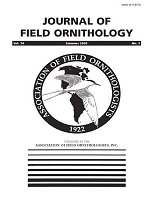Curassows are among the most threatened Neotropical birds, so reliable methods for estimating their abundance are needed to discern distribution patterns and manage populations. Based on the assumptions that the distance to booming curassows cannot be determined reliably and that curassow calling is unpredictable, it has been suggested that curassow abundance should be estimated only through surveys using visual cues. Based on line-transect surveys of Great Curassows (Crax rubra) conducted in a lowland tropical forest in Costa Rica, we show that distance to booming curassows can be measured accurately in the field. We also show that line-transect aural surveys sample curassows over large areas across all forest vertical strata and provide precise estimates of their abundance, but are biased towards detecting males. In contrast, line-transect visual surveys sample only small areas of forest understory and are imprecise, but appear not to be biased towards any sex or age class. We argue that the assumption that curassow calling is unpredictable is not well supported, and we recommend the use of surveys using aural cues to estimate curassow abundance efficiently.
How to translate text using browser tools
1 July 2003
Efficiency, bias, and consistency of visual and aural surveys of curassows (Cracidae) in tropical forests
Iván Jiménez,
Gustavo A. Londoño,
Carlos Daniel Cadena
ACCESS THE FULL ARTICLE
It is not available for individual sale.
This article is only available to subscribers.
It is not available for individual sale.
It is not available for individual sale.

Journal of Field Ornithology
Vol. 74 • No. 3
July 2003
Vol. 74 • No. 3
July 2003
bird counts
Cracidae
Crax rubra
curassows
survey methods




